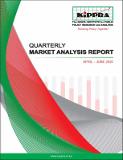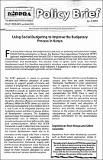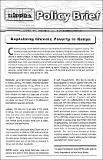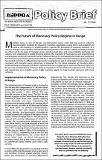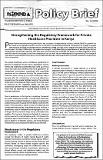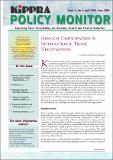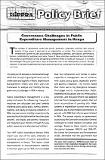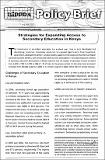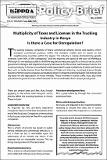Search
Now showing items 1-10 of 159
Quarterly Market Analysis Report April-June 2020
(The Kenya Institute for Public Policy Research and Analysis (KIPPRA), 2020)
This is a quarterly market analysis report prepared by The Kenya Institute for Public Policy Research and Analysis on the performance of the Financial market of Kenya. The report focuses on different sectors of the economy ...
Policy Brief No. 09 of 2006 on Using Social Budgeting to Improve the Budgetary Process in Kenya
(The Kenya Institute for Public Policy Research and Analysis, 2006)
For a long time in Kenya, the budget has focused more on achieving macroeconomic targets .
Despite being participatory in design, the Medium Term Expenditure Framework (MTEF)
approach implemented since the year 2000 is ...
Policy Brief No. 09 of 2007 on Explaining Chronic Poverty in Kenya
(The Kenya Institute for Public Policy Research and Analysis, 2007)
Chronic poverty can be defined in terms of the duration households are trapped in poverty. The
chronically poor are those who are always poor, or usually living below the poverty line. The
chronic poor suffer persistent ...
Policy Brief No. 17 of 2006 on the Future of Monetary Policy Regime in Kenya
(The Kenya Institute for Public Policy Research and Analysis, 2006)
Monetary policy is one of the key macroeconomic policy tools that are used to influence
macroeconomic variables by regulating monetary aggregates and/or terms and availability of
credit in the economy. Its implementation ...
Policy Brief No. 01 of 2004 on Vision and Long Term Development Strategy for Kenya's Tourism Industry
(The Kenya Institute for Public Policy Research and Analysis, 2004)
The capacity of the
country to offer luxury
tourism has been largely
compromised
crowding, over-development
of facilities, competition for
tourists, insecurity, poor infrastructure in general, and
environmental ...
Policy Brief No. 16 of 2006 on Strengthening the Regulatory Framework for Private Healthcare Providers in Kenya
(The Kenya Institute for Public Policy Research and Analysis, 2006)
Private healthcare provision has grown from a few providers at independence to about 2,640 by 2004.This growth can
be traced in two periods. The first was the 1970s when the government allowed civil servants to engage in ...
Policy Monitor, Issue 2 No. 4, April 2004-June 2005 on Kenya's Participation in International Trade Negotiations
(The Kenya Institute for Public Policy Research and Analysis, 2004)
Trade negotiations play a key role in increasing international market access
for exports. Kenya has pursued global integration through trade with other
countries at regional and international level. The main aim in ...
Policy Brief No. 04 of 2007 on Governance Challenges in Public Expenditure Management in Kenya
(The Kenya Institute for Public Policy Research and Analysis, 2007)
The concept of governance covers the social, economic, corporate, political and cultural
aspects of how power is exercised in an organization or society. The common principles in
the exercise of power include: accountability, ...
Policy Brief No. 03 of 2007 on Strategies for Expanding Access to Secondary Education in Kenya
(The Kenya Institute for Public Policy Research and Analysis, 2007)
Policy Brief No. 05 of 2006 on Multiplicity of Taxes and Licenses in the Trucking Industry in Kenya. Is there a Case for Deregulation?
(The Kenya Institute for Public Policy Research and Analysis, 2006)
The trucking industry comprises of heavy commercial vehicles (lorries and trailers), which
transport commercial products within the domestic market and on transit to the
neighbouring countries within the region. The ...

